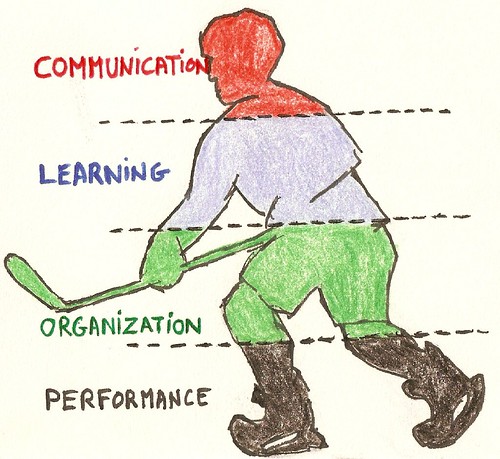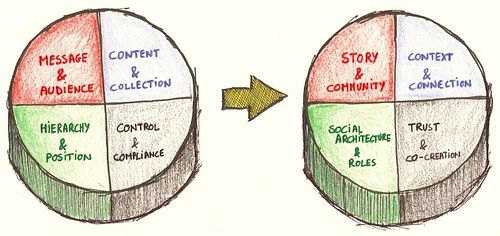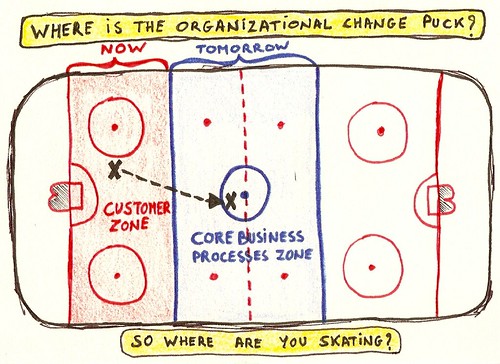Using the ice hockey metaphor to point out where organizational change practitioners should be today, and the direction the puck will be heading tomorrow.
My change management radar for 2011/2012 is focused on the upgrade of the change management portfolio. This upgrade is fueled by the increasing adoption of social media. Looking at the digital economy and how it has changed our daily lives and the business we work in, I am very reluctant to accept that our domain of expertise – Organizational Change Management – would not have changed an inch.
Some of the discussions I have with organizational change practitioners are timeless and time-consuming; i.e.: still discussing and re-iterating concepts of almost 40 years ago (and older). The economy has changed dramatically ever since, but the vantage points are still the same. My suggestion is to look for where our skills will be needed today and tomorrow.
I skate to where the puck is going to be, not where it has been.
Wayne Gretsky
Multiple Intelligences
Turns out that the digital economy not only changed the way we do business but also the way we interact, think and collaborate. Think of it as a new literacy. In our narrow view of the world literacy involves only text, but there is also image and screen literacy. The new literacy, triggered by the internet, is one of information navigation. Information Navigation is a new layer of literacy that adds itself to our multiple intelligence (that is: the literacy of image, speech, text, moving image).
But there is more. Since the last few years the rise of social networks has topped our multiple intelligence with an additional form of literacy. Collaboration intelligence is exactly the skill that is catered for by social media such as Facebook, LinkedIn and Twitter.
The Anatomy of an Organizational Change
The organizational change management approach caters for 4 different elements. They are: Communication, Learning, Organization and Performance. Each element represents a specific need that people have during a change.
- Communication: people need an identity to hang onto so they can see what is in it for them. Constructing an identity for your project is necessary in order to provide an answer to the question “What’s In It For Me?”.
- Learning: People need to know what is expected of them in terms of attitude, knowledge and skills. A part of this is provided in the form of classroom-trainings (the know-how), but the largest part of the knowledge transfer will take place in practice, during the testing phase and the phase of problem-solving. That is why the learning work is never restricted to the classroom and – most of all – we need to carefully build a network of local ambassadors for the project.
- Organization: this is the need to know “Who does what?”. This means that the setup of the future roles and responsibilities needs to be clarified upfront. Next, the support structure in the long run needs to be setup, i.e.: the community of ambassadors who will be responsible for the sustainability of the solution.
- Performance: Finally, people need to know what exactly will change in practice and how this will affect their working habits and usage of time. This includes a detailed follow-up of the chronology of tasks and the creation of a uniform procedure that is shared among all departments.
What the Puck of Organizational Change looks like
Now here is the thing: when social media are changing the laws of gravity for business, there is no way organizational change practitioners can stand aside and pretend that their methods and tools should not be reviewed. What’s more: social media are specifically affecting the core of our business. In other words: the anatomy remains the same, but the focus needs a radical change.
In my opinion, this is how social media is requiring the focus of each of the change management work-streams to shift: players remain the same, but the game is being played on a different level. Therefore it requires a different puck.
On the left-hand side of the drawing above, you can see what change management execution was about before the digital economy got any traction:
- Communication: broadcast your messages to stakeholders (‘Message & Audience’)
- Learning: manage the curriculum (‘Content & Collection’)
- Organization: top-down (‘Hierarchy & Position’)
- Performance: push harder (‘Control & Compliance’)
However, as we are witnessing the end of the Industrial Revolution, we discover that leadership and workplace dynamics are no longer hierarchical. That game is over. Compliance is no longer the shortest path to productivity. When the world changes, the rules change. And if you insist on playing today’s games by yesterday’s rules, you’re stuck. The truth is that relationships are no longer hierarchical, they have become tribal. This means that the new puck of Organizational Change looks like this:
- Communication: listen and trust the process (‘Story & Community’)
- Learning: learning is in the network (‘Context & Connection’)
- Organization: become a platform for change (‘Social Architecture & Roles’)
- Performance: balance push and pull (‘Trust & Co-creation’)
Now that we know about the anatomy of the players and the old versus the new puck of organizational change; let’s zoom in on what the playing field looks like.
Outside: Where the Puck is Right Now
In a world where information is no longer scarce, productivity is about connecting customers and employees in a different way. Like it or not, the internet has shifted the ownership of your brand to your customers. Customers own your brand by advocating or disliking it. Here is the thing: when consumers own your brand, productivity depends on your ability to include customers into the story of your product.
Customer Relationship Management has never been about customers, neither relationships. It has been about systems and about ‘management’ in the narrow sense; i.e.: making sure that customers fit into and behave according to a certain script.
The next thing you know is that social networks are becoming immensely popular and all of a sudden companies want to be present and popular on that level as well. But it’s a Trojan horse, because customers now have the means to hack the call-center scripts and to ‘gate-jump’ to a different game-level: The facebook-pages and all other means of ‘presence’ of an organization are embedded with a dialogue function by default. As a result, there is no way to be present on social media and at the same time not listen to your customers.
The Trojan Horse
On a side note: some of you may remember the video of Michael Hammer where he announced that ERP platforms like SAP were the Trojan horse for bringing down silos on the inside of an organization. It all starts with the implementation of an innocent software, and the next thing you know is that your processes are re-engineered from end-to-end and the company is working in a completely different way.
In the same way as ERP implementations are the Trojan Horse for business process re-engineering, to the same extent social networks are the Trojan horse for bringing down silos between marketing, communication and customer service. Customers are slapping companies in the face(book) publicly and what started out as a marketing campaign becomes a nightmare for customer service.
Only those companies who are prepared to bring down the walls between customer care, marketing and communications will thrive. This is where we – as organizational change practitioners should be today. That’s right: not in the ivory tower of HR/OD, but in the trenches with the call center agents trying to figure out what works in relationship building with customers.
Inside: Where the Puck is Going to be
Now let’s have a look at the next step: to “skate to where the puck is going to be, not where it has been.” (still quoting Wayne here). The same logic applies to internal projects: ownership demands for inclusion of employees into the creative process. These employees in turn will also have upgraded their literacy in the mean time.
Therefore, it is my contention that this same movement will be visible in a few months INSIDE companies. There are already some Trojan horses appearing here and there. Internal social networks such as Yammer and Rypple are spreading like a (healthy) virus. This is where the puck is going to be. The question is: where are you skating?
PS: Tip of the hat to Gail Severini for triggering this article.





Pingback: The OCP Strategy | Reply-MC()
Pingback: Getting Serious about Community Development (Part 3) | Reply-MC()